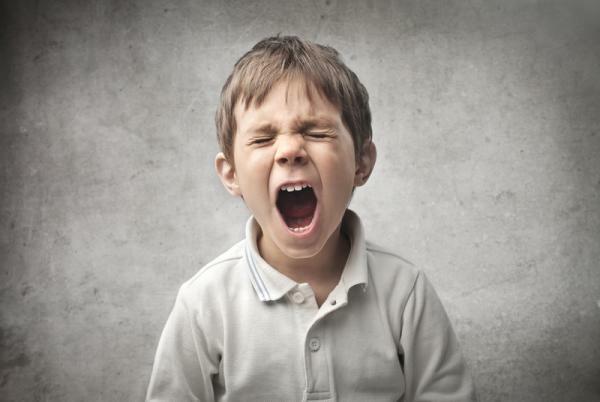
Sometimes we come across people who perform actions out of place, as if they were not aware of what they are doing and can cause shame, anger, anguish and discomfort in others. This could happen in any social context and age, although it tends to be more common in young children. For example, surely you have heard more than one story about someone who has committed a public provocation of any kind. nature that have made you wonder things like "did that person know what she was doing?, why does she have this kind of attitudes? Or, do you understand other people's feelings?, among others. These questions invite us to think about a problem that crosses ages and social groups, known as disruptive behaviors.
In this Psychology-Online article we will talk about the disruptive behaviors: what they are, causes, types and strategies to deal with them.
Index
- What are disruptive behaviors
- Causes of disruptive behaviors
- Types of disruptive behaviors
- Strategies to deal with disruptive behaviors
- Examples of disruptive behavior
What are disruptive behaviors.
Disruptive behaviors are those actions that alter the functioning of a space through the breach of rules and regulations accepted by a society. This type of behavior can occur at any time in life, although it tends to be more frequent in childhood.
Likewise, these manifestations are considered antisocial since they are not accepted by the members of a social group and/or a community. For this same reason, disruptive behaviors can lead to sanctions for the person who carries them out.
How disruptive behaviors manifest
Although not all disruptive behaviors should not be considered disorders, the DSM-V[1] includes them within the group of disruptive impulse control and conduct disorders. However, in order to establish an adequate diagnosis, a series of conditions must be fulfilled. specific criteria:
- Repetitive behaviors of non-compliance with social norms.
- Aggression to people
- Destruction of objects.
- Lack of guilt.
- Lack of empathy.
- This type of conduct lasts for twelve months or more.

Causes of disruptive behaviors.
In order to establish the best treatment for this type of behavior, it is convenient to find the reasons that have given rise to them. Next, we show you the main causes of disruptive behaviors:
Environmental factors
First of all, the traumatic experiences that a person has experienced in their childhood can act as triggers for unfavorable attitudes for the development of daily life, among them disruptive behaviors. Here aspects such as the upbringing of a person, the lack of limits by authority figures or their excessive limitations, among others.
Genetic factors
According to various studies carried out in this regard, it has been verified that there is a clear relationship between disruptive behaviors as a consequence of some alteration of neural function. It should be noted that there are neurons that process information from abroad and give rise to exacerbated anger responses.
On the other hand, there may also be other underlying diseases that have a direct relationship with disruptive behaviors.
Types of disruptive behaviors.
Despite the fact that this type of behavior can happen in any field, here we will focus on some types of disruptive behavior that have certain particularities:
- challenging attitudes: are behaviors that challenge any framework of social order. In this group, the lack of respect towards authority figures stands out.
- explosive attitudes: manifestations of anger that arise suddenly in a person as a result of frustrations to which they have been exposed.
- Aggressive attitudes towards other people: This type of behavior can cause severe physical damage without the person taking into account the consequences thereof.
- antisocial attitudesThey understand signals that avoid social contact. In this sense, a deep lack of interest in being part of social groups may arise, as well as the impossibility of acquiring a sense of responsibility, among others.
- mythomaniac attitudes: mythomania is a personality disorder characterized by the transformation of a fact of reality according to the convenience of a person, a quality that is usually used in people who have behaviors disruptive.
It should be noted that these types of disruptive behaviors can coexist in the same person, although some particular trait usually predominates.

Strategies to deal with disruptive behaviors.
Despite the complexity that disruptive behaviors cause, there are some methods to reduce their consequences. Here are some strategies and activities to eliminate disruptive behaviors:
keep clear boundaries
This type of behavior often derives from the lack or excess of limits of the authorities entails. Therefore, if the person notices that they can carry out some action that alters the order to achieve what they want and there is no clear limit, this can become somewhat repetitive.
Given this, set clear boundaries, concrete and inflexible can help reduce these disruptive behaviors.
Establish punishments for disruptive behaviorsyes
If the way of acting of a person who causes problems in a certain place does not have any kind of consequence, it is likely that this pattern will repeat itself. On the contrary, the establishment of punishments may allow us to better deal with this situation.
Foster a secure bond
In general, people who exhibit disruptive behaviors have many feelings of insecurity. For this reason, in these cases it will be convenient establish arelationship based on trust so that the person feels understood.
If you want to know more about how to create safe links, you can also read the article Secure attachment: what it is, characteristics, types and how to promote it.
Anticipation of situations
On some occasions, the frustration triggered by moments that we did not expect causes considerable discomfort in a person. Faced with this type of situation, plan and anticipate a situation it can also be a good way to deal with disruptive behaviors.

Examples of disruptive behaviors.
To provide greater clarity to this subject, here are some examples of disruptive behaviors that can be common in social fields:
- Example 1: A boy is sitting in a school classroom in the middle of a class. Because the content explained by the teacher is boring, he begins to hit his classmates and various objects in the classroom. In this case, the disruptive behavior derives from the discomfort that has been felt during all this time.
- Example 2: A person goes to her work and is informed that her employment contract has not been renewed. Faced with the frustration that this situation produces in him, he begins to throw objects out of the window and threaten the employees with physical harm. Then, hit and injure one of them. In this way, the frustration was channeled through disruptive behavior.
It should be noted that the above examples do not emphasize any particular moment and are for illustrative purposes only.
This article is merely informative, at Psychology-Online we do not have the power to make a diagnosis or recommend a treatment. We invite you to go to a psychologist to treat your particular case.
If you want to read more articles similar to Disruptive behaviors: what they are, causes, types and strategies to deal with them, we recommend that you enter our category of Clinical psychology.
References
- American Psychiatric Association (2013). Diagnostic and Statistical Manual of Mental Disorders (5th ed.). Arlington: Panamerican Medical Editorial.
Bibliography
- Jurado de los Santos, P., Justiniano Domínguez, M. d. (2016). Proposals for intervention in the face of disruptive behaviors in compulsory secondary education. Spanish Journal of Guidance and Psychopedagogy, 27 (3), 8-25.
- Rodriguez Garcia, v. AND. (2021). Managing disruptive behaviors in the classroom. Magazine of Scientific Diffusion of the Educational Sector, 23 (2), 5-11.
Disruptive behaviors: what they are, causes, types and strategies to deal with them


